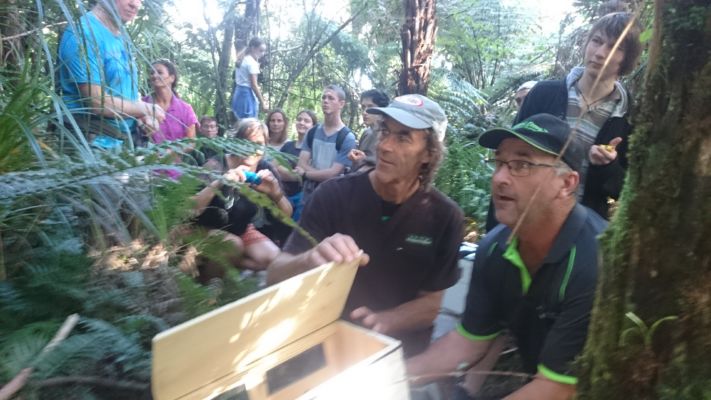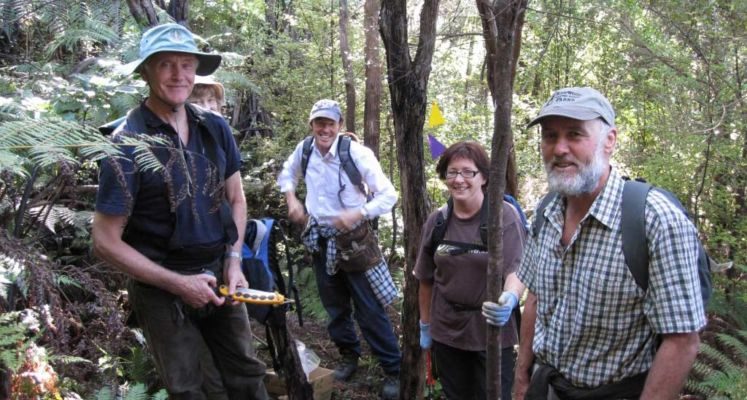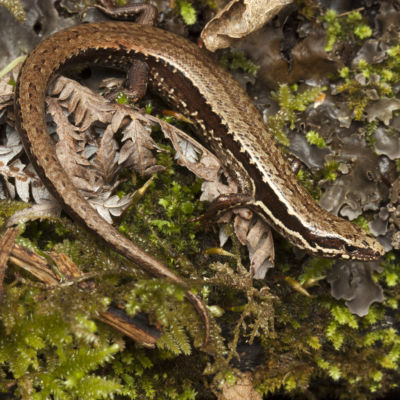In 2013, rangers at Bream Head Scenic Reserve, in the Whangarei Heads area, discovered a species of skink completely new to science. It is just one of the exciting discoveries made by Bream Head Conservation Trust.

The coffee-coloured skink is a distinct species – appropriately named Oligosoma “Bream Head” – and is found within an area of less than a hectare. It is successfully breeding and gradually becoming more abundant due to predator control. Local herpetologist, Ben Barr, reports that it is very curious, loves sunbathing and climbing trees.
Bream Head Scenic Reserve is a coastal broadleaf forest, reputed to be the best example of such forest in Northland. The forest is unusual too, in that it comes right down to the shore and has a southerly facing aspect. Being on a headland, it is also a defensible area – with a limited land boundary across which predators can reinvade.
Last April 40 North Island robin were released at Bream Head. They are fun and friendly and find you when you make noises. The robins have bred successfully over summer and in April 2017 another translocation is planned – this time to release whiteheads in the area.

Stringent criteria need to be met before DOC will authorise translocations, so the release and breeding of the birds are an endorsement of the predator control and habitat restoration carried out by the Trust. The whitehead translocation will also demonstrate that pest eradication work over more than a decade is now allowing the natural biodiversity to recover.
Robins and the eagerly anticipated whiteheads aren’t the only birds to return to the area.
“Our trapping programme is helping birds to feel safe again,” says Claire Pearson, communications committee organiser and trustee. “Many are returning naturally.”
Several predator-free islands like the Hen and Chickens off-shore of the Heads, serve as a reservoir of native species. Kaka and bellbirds are among those that have returned of their own accord.
Grey-faced petrels too, have returned to nest on Bream Head for the past two years. But nesting failed in the first year – probably because of stoat predation.
“We ramped up trapping in the area this year,” says Claire, “But this year petrel nesting failed again. It only takes one stoat.”

Trapping has been a big part of the work of Bream Head volunteers and rangers since the early days of the Trust.
“We started in the middle section of the reserve,” says Claire, “and now the whole reserve is intensively trapped. It was part of our 5-year plan and now it’s been achieved. We started with 1 ranger and now have 3, along with a really enthusiastic, hard-working, strong group of volunteers.”
In 2001/2002, when the Trust was being formed, a predator-proof fence was investigated for Bream Head which is bordered on three sides by the sea. It’s a naturally defensible area suitable for fencing, but costs proved too prohibitive.
“We could never have raised the funds,” says Claire, “And then there are the ongoing costs of maintaining the fence. We found we could get really good results without a fence.”
It helps too, that the group has strong support from the wider community.
“We’re a community driven group,” says Claire. “The whole community is very passionate about conservation.
Pest eradication efforts extend beyond our boundaries. Individual farmers, small groups of residents and landcare groups are making a difference.
That wider community trapping programme is contributing to efforts to create a Kiwi Coast corridor where kiwi are safe to travel along the east coast of Northland.

Other wildlife also abounds in the reserve. A rare kumara moth caterpillar was recently spotted there and, as well as the newly discovered ‘Bream Head’ skink species, two more lizards – the moko skink and forest gecko – were seen at Bream Head for the first time in 2014. In total, nine lizard species are known to live in the Whangarei Heads area – pretty impressive for a mainland site.
Regular bird monitoring and lizard surveys are carried out by rangers and volunteers, as well as predator trapping and large community planting days. The Trust has an extensive habitat restoration programme and the stats are impressive. Over 37,000 trees and plants were planted between 2002 and 2015. What’s more all seeds for those 37,000 plants were collected in the reserve.
Volunteer Wendy Holland collects the seed and takes it to the Kerikeri Shade House where the manuka, kanuka, flax, cabbage tree and pohutukawa are grown on by another group of dedicated volunteers. Two years later the plants are returned to Bream Head – but even that can be something of a challenge. Planting sites aren’t particularly accessible. Sometimes plants have to be offloaded by boat.
Bream Head is a big project and there’s always plenty to be done.
“We’re pretty active,” Claire concludes. “We have a lot of talented people in the Trust and in the community.”

